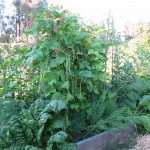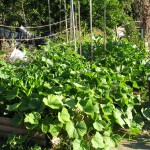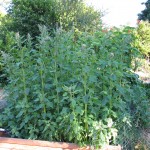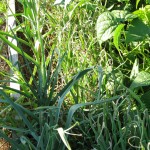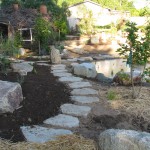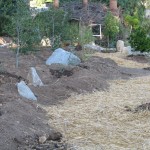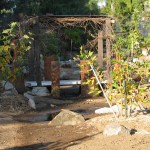-
Oatey Scones

Oatey Scones I’ve made traditional scones for years as a breakfast treat. They are quick, easy to make from scratch, and oh! so good. However, when I found this recipe for oatmeal scones in Cook’s Illustrated (September and October 2003), it was my lucky day. I really love these tasty devils. The trick is to toast the oatmeal before incorporating it into the batter.
Oatey SconesAuthor: Cook's IllustratedRecipe type: BreakfastPrep time:Cook time:Total time:Serves: 8These toasted oat scones are heavenly, especially with mascarpone cheese, fresh fruit or lemon curd.Ingredients- 1½ cups old-fashioned rolled oats or quick oats
- ¼ cup whole milk (I've used 2% milk just fine)
- ¼ cup heavy cream
- 1 large egg
- 1½ cups unbleached all-purpose flour
- ⅓ cup sugar
- 2 teaspoons baking powder
- ½ teaspoon salt
- 10 tablespoons cold unsalted butter, cut into small cubes
- Coarse sugar for topping.
Instructions- Heat oven to 375 degrees F.
- Spread oats evenly on a baking sheet and toast in oven until fragrant and lightly browned, about 7-10 minutes, stirring twice; cool.
- Increase oven temperature to 450 degrees F.
- Line a baking sheet with parchment paper.
- When oats are cooled, measure out two tablespoons and set aside.
- Whisk milk, cream and egg in a large measuring cup.
- Stir together flour, sugar, baking powder and salt until combined.
- Scatter cubed butter over the top of the dry ingredients and with your fingers, a fork or a wire pastry blender incorporate until mixture resembles coarse cornmeal.
- Stir in cooled oats.
- Using a rubber spatula, fold in all but a tablespoon of the liquid ingredients until large clumps form; continue gently folding until dough forms cohesive mass.
- Dust work surface with reserved oats and a little flour.
- Turn wet dough (it will be damper than you'd expect!) onto surface and gently pat into a 7-inch circle about 1 inch thick.
- Using a bench scraper or chef's knife, cut dough into 8 wedges and set about 2 inches apart on parchment-lined baking sheet, reshaping as needed.
- Brush tops of scones with reserved liquid and sprinkle with coarse sugar.
- Bake until golden brown, 12 -14 minutes.
- Cool scones on baking sheet on wire rack for 5 minutes, then remove scones to cooling rack and cool to room temperature (so they won't fall apart), about 20 minutes.
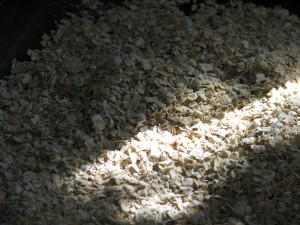
Toasting the oatmeal makes all the difference Watch the oats carefully so that they don’t burn, and give them a stir now and then. While they are achieving all that wonderful toastiness, combine the cold butter and the dry ingredients until it looks like coarse cornmeal.
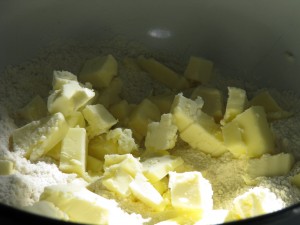
Incorporate butter into flour The batter will be suspiciously wet; don’t be alarmed. The dry oatmeal will soak it all up as the scones bake, and it all works out happily in the end. However it will be a little difficult to cut the scones and transfer them to the baking sheet; a little reforming might need to take place, but that’s okay. Bake until golden brown.

Bake until toasty brown The scones will be brittle until they cool, so let them sit for about twenty minutes or so (if you can!) before serving. If you are serving these to guests or as part of a larger breakfast, this waiting time can be a good thing… most other scones want to be served hot from the oven and leave you no time to do extras.

Serve cooled, so they won't fall apart Oatey scones are wonderful plain, with sweet butter, or (my absolute favorite) with mascarpone cheese and fresh fruit. The wholesome toasted grain flavor of the scones make a fabulous backdrop to the fresh plain flavor of the cheese and the sweet/tart flavor of fresh strawberries, peaches, plums, or whatever you have.

Serve with mascarpone cheese and fresh fruit - Animals, Gardening adventures, Heirloom Plants, Other Insects, Permaculture and Edible Forest Gardening Adventures, Photos
Ladybugs

Insect Egg Cluster on Parsnips My daughter’s eagle eyes spotted a cluster of insect eggs on the underside of our parsnip leaves. Many moths and butterflies are laying their eggs right now, so seeing a little white pearl glued to the underside of a leaf isn’t strange.

Unknown Butterfly Egg The parsnips in question are late in the garden; they’ve been in the ground for a while and don’t like the heat so they are stressed. Just as we become sick when stressed, so do plants, and the parsnips are under attack by aphids and ants. Ants feed off of the sticky excretions of the aphids, so they have become ranchers. Ants cultivate herds of aphids on stressed plants, grooming them and collecting their, um, poo. So trying to put that image out of your head, if you see a lot of ants on a plant, expect aphids to be there also. Aphids have rasping, sucking mouthparts that they use to eat away at a plant and suck the vital juices out of it. Sorry, there is another image that you probably don’t want. How to get rid of aphids? The natural way would be to make sure your plants aren’t stressed, and allow ladybugs to flourish in your garden.
So what would you do if you saw THIS in your garden?

Ladybug Larvae Eating Aphids Run screaming? Hit it with a trowel? Wait! You shouldn’t do any of those things! These are baby ladybugs! Just as many children do not resemble the adult into which they will grow, ladybug larvae look like something that Godzilla might take on… if the larvae were the size of a house or something, which they aren’t. Okay, I’m digressing here.
Back to that cluster of eggs my daughter saw. They were hatching ladybug larvae!

Hatching Ladybug Egg Cluster I’ve never seen them that small before. Good news for the garden: rescue forces are being hatched!

Ladybug Larvae Hatching Ladybug larvae eat more aphids than the adults do (just think of teenagers and refrigerators). When they’ve grown as much as they can, they will transform in to the ladybugs that we all know and love (even though we sing a horrible song to them about leaving the garden to check on a false alarm about fire and their children. And people complain about not being able to keep ladybugs in their yards!)

Ladybug! So if you see a creepy bug on your plants, the sides of your house… anywhere… don’t squish him! It may be part of the Ladybug Larvae Special Forces out to break up the illegal ant ranches in your garden!
-
Roasted Radishes, or What Not to Bring to a Party

Radishes About to be Roasted I don’t have much luck bringing food to events. When I need to bring food to a party, I seem to have some strong internal drive to fix the most inappropriate thing, and go through agonies to make it. Some mischievous elf in my head sends down strange images to my consciousness telling me what to make as soon as I volunteer. The food is good…. it is usually a recipe that I’ve made before and think is interesting and different. I’ve brought cornbread made with blue cornmeal to picnics, and people have shunned it thinking it was blueberry flavored, or an ugly homemade unfrosted cake, and gone on to the easily recognizable chain-store brand cookies lined up in a clamshell container.
When asked to bring a cake, I make some complicated thing that never looks as good as the picture in my head. My cakes are very tasty, but my decorating skills are, shall we say, possible candidates for cakewrecks.com. I’ve done a cake for a grand opening of a park where I simulated a pond with cattails made of broken pretzel sticks, or that is what it was supposed to look like. I made not one but three types of jelly roll cake with three different fillings for a bridal shower, and the day was so hot that the cakes kept sticking and sliding and I had to keep running up and down the stairs to the garage refrigerator to chill them. I actually sat down and cried because I was so frustrated and had spent the entire day baking in a heat wave with a mess to show for it. I ended up arranging the individual cakes in a flower shape and sprinkled dried rose buds and edible glitter around. It looked pretty, if amateurish, but I knew they’d taste wonderful. It was so hot in the car I thought I would be redecorating my Prius with homemade lemon curd and chocolate filling. I had to stick the large pan in the surprised hostess’s refrigerator, which took up a lot of space. Then when it was cake time, I found that the jelly rolls had already been sliced up and plated so that you couldn’t tell the flavors apart and all the rosebuds thrown out, without the bride-to-be or anyone else even seeing it. I could have just made a sheet cake and everyone would have been happy.
I’ve brought vegetarian main dishes that no one but my children and I seem to want to eat, even though they aren’t creepy tofu-y mock turkeys or anything. Labeling a dish ‘vegetarian’ is like putting a curse on it, although many dishes other people bring don’t have meat in them either. To be ‘vegetarian’ means scary, weird food of unknown origin that probably tastes like sprouts or tofu or whole wheat.
I know when my offerings are rejected, it isn’t really the food… the food tastes good. That is, if anyone dares eat it. It is just out of place, just as I am at most parties. My food and I belong at small gatherings of friends who are expecting a new experience. Who want to try something different and talk about it. Who enjoy subtleties of flavor and the goodness of fresh herbs and spices. Who don’t judge on how good a dish appears, but how it tastes. Who are forgiving and especially have a good sense of humor.
Which brings me to another example of something not to bring to most parties: roasted radishes. Especially to one where there is a lot of drinking going on. Everyone will wonder what they are and no one will touch them because there is perfectly predictable Albertsons layered nacho dip and bagged chips right next to them. Since roasted radishes aren’t the prettiest looking things, they will be the last edible thing on the buffet table besides the really, really cheap half-finished bag of corn chips, and when everyone is really, really drunk, some unpleasant personal comments might be said about their appearance. The radishes will be cold and soggy by that time, too, and not the best thing for someone with a lot of alcohol in his or her system to put into his or her mouth at that point. However, if served at home as an interesting appetizer along with something less scary-looking, these are just great. No, really, they are. You should try them. I was impressed enough to try to force them on strangers at someone’s home, so you should be, too.

Roasted Radishes dressed up for a party Growing radishes is very easy and quick, and roasting them gives you something to do with them. Radishes only take a few weeks to mature, so they are often the first thing up and ready in the garden. Give this recipe a try the next time you roast veggies; many people who don’t really like radishes enjoy them this way.
Roasted RadishesAuthor: Diane C. KennedyRecipe type: Side DishPrep time:Cook time:Total time:Roasting radishes changes their flavor and texture to something new and delightful.Ingredients- Three bunches radishes, preferable different colors if you can find them
- Three tablespoons extra virgin olive oil
- ½ teaspoon dried thyme leaves
- ⅛th teaspoon cayenne
- Freshly ground black pepper
- Coarse salt
Instructions- Preheat oven to 425 F.
- Wash radishes and cut all but a little tuft of radish leaves off of each radish. Don't cut off the roots.
- In a medium bowl whisk oil, thyme, cayenne and black pepper.
- Add radishes and toss to coat.
- Pour radishes onto a flat baking pan and drizzle with any remaining oil mixture.
- Roast 40 - 50 minutes, turning once midway through roasting, until a knife easily slides into a radish and they are lightly browned.
- Sprinkle or grind coarse salt over the tops.
- Serve immediately.
-
Goat Milk Crumbly Cheese
A friend of mine and her daughter have several goats and this year they began milking them. Every day. Twice a day. Not without a struggle. As they are lacto-ovo vegetarians as well, they don’t use that much milk. However they have experimented with kefir and cheese. Now they are experimenting with giving some milk away.
I have been a lucky recipient of a quart of freshly milked, unpasteurized goat milk. I intended to make cheese out of it, and in the heating for the cheese the milk would become pasteurized.

Heat Slowly I’ve learned a little about making cheese, and I’d like to learn more. What I made was an easy acid-based spreadable or crumbly cheese. This requires lemon juice or vinegar added when the heated milk reaches 180 degrees F.

Stir in Lemon Juice until Curds Form The milk immediately separates into curds and whey.

Pour Curds and Whey into Cheesecloth This is poured through cheesecloth,

Tie Cheese into Cheesecloth then all four corners tied and the cheese suspended over a pot or bowl to drain.

Hang Cheesecloth Over Pot to Drain My result was like a dry cottage cheese. I hung it longer than recommended, so perhaps too much moisture seeped away. Then, before I combined it with seasonings, I put it into the refrigerator since I was busy with something else. I think that hardened up the cheese as well. The seasonings didn’t so much as combine with the cheese curds as they just mixed up with them.

Mix Crumbly Cheese with Seasonings That worked out okay. Instead of spreading the cheese on toast, I crumbled it into a vegetable and pasta dish for dinner and it was tasty, as well as a good extra source of protein, and just fun to eat because we had made it from the milk of goats we have met!

Serve with Pasta and Vegetables A quart doesn’t make much cheese; in fact, it made about half a cup of crumbly cheese.
The whey is a rich souce of nutrition, but is often thrown away. With the acid added to it, it has an unpleasant flavor for drinking. I used it, with the addition of more water, to boil the pasta for the meal, then after it cooled poured it on my outdoor plants. You can use it to replace water in baking or feed it to your chickens… just don’t dump it down the sink!
This recipe is for a quart of goat milk, which doesn’t produce much cheese. Recipes I looked at all recommended a quarter cup of lemon juice, but the cheese curdled for me at no more than an eighth of a cup. Maybe you’ll have different results. You don’t have to hunt down a goatkeeper, either. Goatmilk is sold in supermarkets.
Crumbly Goat Milk CheeseAuthor: Diane C. KennedyRecipe type: Side DishPrep time:Cook time:Total time:Serves: ¼ cupHave a quart of goat milk? Make a little cheese with it!Ingredients- One quart fresh goat's milk
- Up to ⅛th cup fresh lemon juice or vinegar
- Seasonings such as half a garlic clove grated, thyme, Herbs du Provence, etc., and coarse salt
Instructions- Affix a cooking thermometer to the side of a medium saucepan.
- Add goat milk so that the thermometer is submersed in the liquid but not touching the bottom.
- Heat over medium heat until the temperature reaches 180 F.
- Remove pot from heat and gauge from side of pot.
- Stir in lemon juice or vinegar a teaspoon at a time until curds form. You'll know it when it happens! There will be curd and almost clear whey.
- Line a bowl with double layer cheesecloth.
- Pour contents of pot into cheesecloth.
- Tie corners of cheesecloth together over a wooden spoon and allow to hang over bowl or pot to drain.
- Drain cheese one hour or more. The longer you drain it, the more dry it will be.
- Remove cheese from cheesecloth and place in bowl with the seasonings of your choice. Sprinkle with coarse salt.
- Use crumbly cheese on top of hot pasta or vegetables.
- Gardening adventures, Permaculture and Edible Forest Gardening Adventures, Ponds, Rain Catching, Vegetables
Yesterday in the Garden
Yesterday was the solstice, the formal beginning of summer. The longest day of the year. (Only six months to Christmas!) With months of growing season already behind us here in San Diego County, and the threat of drought and fire ahead of us, it is a time to enjoy the bounty that we already have. This is my year for gardening: I have the best vegetable garden I’ve ever had, after years of building raised beds and lining with aviary wire against gophers, improving the soil with compost, and buying organic seeds and fertilizers. I also have incredible freedom in my yard to plant whatever I like, wherever I like (within the constraints of tolerance by the plants). I’ve always had to cluster plants around where I’ve slapped together irrigation on the few stolen weekend hours I could devote to my yard. No more! With the permaculture gardens, the well and the drip irrigation, I am excited about my yard for the first time in the twelve years I’ve lived here. With the incredible job that Roger Boddaert and his team of Juan and Francisco, and also Aquascape’s Aart DeVos with his manager Jacob who has spent thirteen hour days on my property and is back early the next morning, the permaculture project is nearing completion and is spectacular. As a habitat it is succeeding, attracting more wildlife every day. As a food forest it has is off to a good start, with extra going to go to the Fallbrook Food Pantry. As an interesting, decorative garden it is unique and full of surprises. I’ll show you some photos; you can click on any of them to enlarge, but it will open in this window and you’ll have to use the back arrow to return to this page:
Long Scarlet Runner Beans Vigorous vines Little pickling cucumber Towering Quinoa Seeds on multiple stems Garlic Nearing Harvest Time First zucchini harvest Through the main entranceway Streamside walkway Mulched beds with swales Tin-roofed bridge The Palm Aisle My First Yacht Yarrow between the stepping stones -
Is She a He???
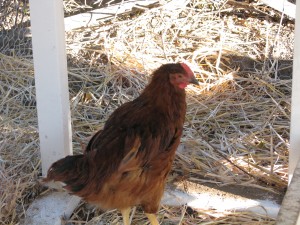
Rooster in Disguise? Problems in Chicken Land! Of the seven hens we’ve raised from chicks, one has played us false! Or so my daughter (the birder) speculated upon her arrival home from college. Our one Rhode Island Red, which is a larger breed so we chose the smallest chick in the batch, is showing signs of not being, shall we say, hennish. First of all, she is large. Really big feet. Ever hear the Fats Waller song, Your Feets Too Big? That applies here. Most notably, though, are her tail feathers, which are starting to take on a more colorful life of their own. They are a little longer and have some bluish-green hues in them that hens, well, just don’t care about. She has become a bully to all the others, especially the largest Americauna, Chickpea.
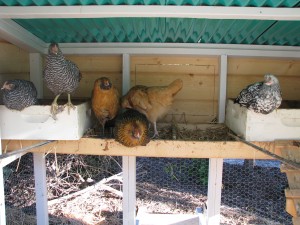
And I thought they were being hen pecked! I had attributed the temper to her being a redhead, but apparently there are other explanations. She is developing admirable wattles, which is something I don’t get to say to just anyone. Also, she has very shiny neck feathers, and roosters have an oil gland they use to preen their feathers. However, she hasn’t yet crowed, but Internet research tells us that some crow early, some late, some not at all. Also, she hasn’t grown spurs yet, but the story is the same as the crowing. One chicken site informed us that it was easy to sex Rhode Island Red chicks because the females have a black stripe on their heads.

It seems like only yesterday.... No stripe on this one, yet if it is so easy to sex them, why was this male in with the females at the store? If indeed she is a male.

Trying to blend in.... So what if she is a he? I don’t know yet. My neighbors would have a fit if I had a crowing rooster in my yard. Rural as it is here, there is a certain peacefulness that rolls across the land and a screaming bird just doesn’t fit in. Also, I’m a lacto-ovo vegetarian. I eat eggs, but not animals, so I don’t want fertile eggs or chicks. Nor do I want my other girls harassed all the time. However, I’ve raised this bird from a day old, and I don’t give over my responsibilities lightly. The hens won’t begin to lay for a couple more months, so I have some time to consider.
I wonder if my vet would fix a chicken?
Here is the whole cast of characters:
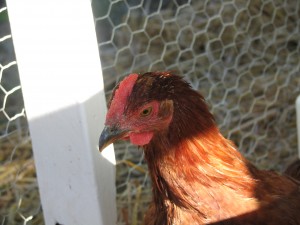
Emerson Emerson: if our speculation is in error, and she is not a he, but she is a she, then she can assume the name Emily.

Blondie/Evelyn Blondie. Not the most original name, but the song Heart of Glass comes to mind whenever I see her. Blondie is Emerson’s chosen consort (another reason Emerson must be a male…. going for the blonds!) UPDATE: Blondie has been renamed Evelyn to move from music to fiction genres. Emerson, Miss Amelia and Eveyln are all characters in Elizabeth Peter’s Amelia Peabody series.

Lark 
Linnet Lark and Linnet: the youngest chickens by a few weeks, these Barred Rocks pair off and are quite smart. Comparatively. Lark is darker than Linnet.
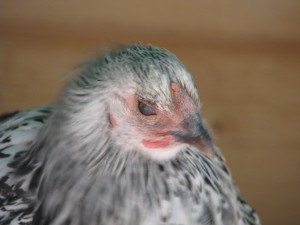
Miss Amelia Miss Amelia: the Silver Wyandotte. Named after the intrepid heroine of Elizabeth Peters’s Amelia Peabody historical archeological mysteries. She likes to sit on the highest perch.

Kakapo (a New Zealand bird... she looks like one!) Kakapo: the lighter colored Americauna. Her posture and neck feathers are much like the New Zealand bird after which she is named.

Chickpea Chickpea: the largest Americauna since the beginning, but the most picked upon. Her coloring is dark where Kakapo’s is light. She manages to hide under the others effectively.
If it’s not one thing, it’s another!
-
Plummy Skillet Cake

Golden plummy goodness Have a lot of juicy plums that need a place to go?

Eating fresh plums in the sunshine with the juice dripping down your chin is like sipping nectar in paradise. How about this tasty, light cake baked in a skillet? A cast-iron skillet is perfect for this cake, but you can use any oven-proof skillet or baking dish if you don’t have one. If you are skilled in campfire or Dutch-oven cooking, take this recipe with you when you camp. As an interesting change of seasonings, use the Chinese Five-Spice powder that has been hanging out in your spice pantry since the last time you made stir-fry.

Chinese Five-Spice powder and plums are a great combination If you don’t have any, use freshly-grated nutmeg or ground cinnamon.
Plummy Skillet CakeAuthor: Diane C KennedyRecipe type: DessertPrep time:Cook time:Total time:Serves: 6Dessert in a cast-iron skillet can be cooked over a campfire instead of your oven. No cast iron? Use an oven-proof skillet or baking dish. You can use other stone fruit instead of plums with just as good a result.Ingredients- 6 tablespoon unsalted butter, room temperature, plus extra for skillet
- 1½ cups all-purpose flour, plus some for skillet
- ¾ teaspoon baking powder
- ½ teaspoon baking soda
- ¾ teaspoon salt
- 1 teaspoon Chinese Five Spice powder
- 1¼ cups plus 2 tablespoons sugar
- 2 eggs
- ¾ cup buttermilk
- 4 medium plums, thinly sliced and halved
Instructions- Preheat oven to 375 F.
- Butter a 10-inch cast-iron skillet (or ovenproof skillet or dish).
- Dust skillet with extra flour and tap out any loose flour
- In a small bowl, whisk together flour, baking powder, baking soda, Chinese Five-Spice powder and salt.
- In large bowl, or in a mixer bowl, combine 1¼ cups sugar and butter until creamy.
- Beat in eggs until smooth.
- Add a third of the flour mixture with a third of the buttermilk, until all is combined. Don't overbeat.
- Pour batter into prepared skillet and smooth top.
- Spread sliced and halved plums all over the top.
- Sprinkle with extra sugar.
- Bake 35 minutes until golden brown and a toothpick inserted into the center comes out cleanly.
- Cool for about ten minutes before cutting.

Bake until golden brown -
Cob Oven, Part One

Levelling the firebricks Today six members of the San Diego Permaculture Group converged upon my property to build a cob oven. No, not with corn cobs. Cob is an ancient building method that is similar to adobe, but without the brick. Cob buildings, some of them several stories high, have stood for centuries in as diverse areas as Turkey and Wales. Building a cob outdoor baking oven is a good exercise in cob building that is useful and easy. None of the members, nor my daughter who jumped right in to help mix mud, had made a cob oven before. That was okay, because neither had I! Using as a reference the book Build Your Own Earth Oven by Kiko Denzer, and having watched several YouTube cob oven videos, we set off on our learning experience with the energy and fellowship that this newly formed group radiates.
Because of all the deconstruction on my property, building materials were at hand. I decided to set the oven on a cement platform left from a torn-down shed. That eliminated digging and filling a drainage base. My son had helped carry bags of sand down to the work area, which besides straw and wood shavings were the only items I purchased for this project. With broken concrete and cinderblocks, the group made a circular base about two and a half feet high.

The base made with cinderblock and cement chunks The height helps the back of the baker, but if the oven isn’t used all day every day, a shorter one isn’t going to be a problem. Especially for a short person like myself. Not that short, but short.
When I moved onto the property there was all this gravel and stone around. I hated it. I removed a lot, but much disappeared into the pathways. Some has resurfaced with the tilling that has been done to loosen the soil and add mulch. We gathered a lot of the stone along with some dirt and used it to fill the base.
Then we made some rough cob. There was a pile of hard clay that came from the pond excavation. In fact, the bottom of the pond, which is unlined because of the clay content, is almost pudding-like in consistancy with the silky clay. How do I know? Well, let’s say that on a hot day this last week I got to know my pond a little better.

Collecting clay samples with my feet Anyway, the clay contains really hard lumps. It will make wonderfully strong cob, but first it has to be broken down. My daughter filled a wheelbarrow with it, then we dumped it out onto a tarp and added water, expecting it to be easy to mix when wet. Wrong!
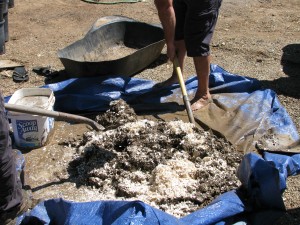
This insulation batch is made with clay, sand and wood shavings We added a lot of water and some sand, and mixed pretty well, then added some wood shavings to it for tensile strength. This was used to gap holes in the oven stand and form a base for the insulation. The insulation was made of the flat vodka bottles somebody in the history of this property obviously preferred, along with a broken necked Coke bottle that were found when the pond was excavated. Pretty cool, huh?
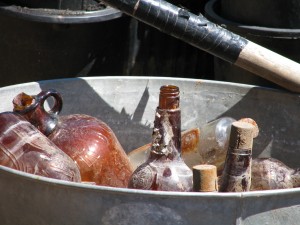
A treasure of old bottles 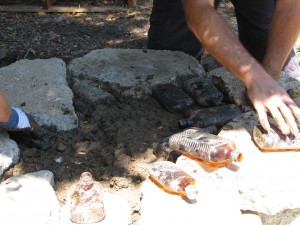
Bottles were layed on cob for insulation Meanwhile, another wheelbarrow was filled with clay and water, and a group started using their hands to mix it and disintigrate the hard lumps if possible. This took a long time, and still there were lumps. The scene looked like the part in Moby Dick when the whalers are kneeding the blubber with their hands, only a lot less gruesome. This clay mix must be smooth for the next step, building the oven itself.
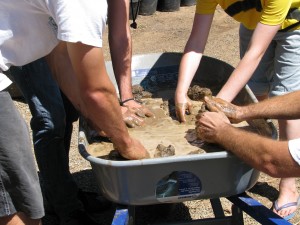
Finding the lumps in the clay On top of the bottles went a layer of sand, which was levelled as best we could. On top of that went firebricks, which were also levelled.
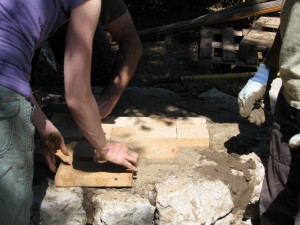
The firebrick was layed on sand At this point we stopped due to time. The whole process was only a little over two hours long. The wheelbarrow of prepared mud has been covered, as has the oven base. In the very near future we plan to reconvene and make the rest of the oven. After that… pizza!

Everything was even except the middle -
Savory Carrot Soup

Freshly Pulled Carrots Carrots are a gardening miracle. From such a minuscule seed, out pops a root strong enough to plow through tough soil and soak up minerals.

Little Sprouts The carrots shoot those minerals up to the ferny leaves, and when they die, leave the minerals to enhance the topsoil. Carrots fill the roll as one of nature’s miner plants. They are also terrific to eat and very good for you.
I’m sure you’ve heard about how high in beta-carotene carrots are, and how they help eyesight. If you haven’t there are hundreds of Internet references to look up. Carrots are a very versatile vegetable, tasty raw as well as cooked.

Nantes and Chantenays There are many carrot varieties. Nantes, Chantenay, Danvers… these are the common varieties you’ll see sold in most seed stores. However there are white carrots, purple carrots, deep red carrots, and carrots of many sizes and shapes. Some are woody, some very sweet, some tender and some strongly flavored.

Feel around the carrots to see if they are ready to pull 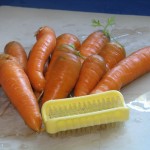
Garden carrots need only scrubbing, not peeling If you grow your own organic carrots, feel around the roots to see if they are large enough to pull. Don’t leave them in the ground for too long or they’ll become less sweet and woody in texture. Also, if you use your own organically grown carrots, you don’t need to peel them. Just use a brush to scrub off the dirt.
Carrots are wonderful to eat when simply steamed until tender, then buttered or drizzled with olive oil and chopped herbs. Dill is particularly good, as are chives. I’ve found many carrot recipes, but most of them are sweet not savory. Honey-glazed carrots, carrot soup with curry and sweet coconut milk, brown sugar carrots… I don’t care for them. Carrots are naturally sweet, and to slop more sweet stuff on top is overdoing it. Sweetened carrots belong in carrot cake, and there is only one recipe for it that I find not cloying and heavy (I’ll share that recipe with you another time). I also like carrots in a savory soup.
Here is an unusual recipe that is tasty, easy, low in calories, and has protein from an unusual source: vegetarian sausage patties. Celery adds dimension to the flavor as does minced fresh rosemary.

Minced Fresh Rosemary Savory Carrot SoupAuthor: Diane C. KennedyRecipe type: SoupPrep time:Cook time:Total time:Serves: 2This golden, low-fat soup brings out the savory goodness of carrots.Ingredients- About two cups sliced carrots
- One shallot, diced
- One celery stalk, diced
- Two vegetarian sausage patties (such as Morningstar Farms)
- 1 tablespoon olive oil
- ½ teaspoon fresh rosemary, minced
- One large potato, peeled and chopped
- Four cups vegetable broth
- Cilantro leaves for garnish (optional)
Instructions- In medium saucepan, heat olive oil over medium-high heat. Add shallot and cook for two minutes.
- Add celery and stir occasionally for about three minutes.
- Move the vegetables to one side and add two vegetarian sausage patties. Flip when cooked on one side.
- Add potato, carrots and rosemary.
- Stir, breaking up sausage patties with spatula.
- Add vegetable broth
- Bring to boil then lower temperature to a simmer and partially cover with the pot lid.
- Cook for about twenty minutes, until carrots are just tender.
- Cool, then blend soup until smooth.
- Return soup to pot and reheat.
- Serve hot, topped with cilantro leaves if used.
Serve this golden orange soup in bowls that compliment it’s color.
Serve in Bowls that Compliment the Rich Soup Color -
Locro de Papas (Ecuadorian Potato Soup)

Locro de Papas A couple of years ago my daughter and I went on a birdwatching ecotour of the cloud forests in Ecuador, and then to the Galapagos islands.

Me and Galapagos Sea Lions The flights ended and began in Quito, the capital city, which holds about 75% of the entire population of Ecuador. Eating wasn’t as much a challenge as we had anticipated; often in lower economic areas there are better non-meat choices. We stayed at a hotel in Quito at the beginning, middle and end of our journey. Room service was the same price as eating in the restaurant, so we indulged in our room for most meals because we were exhausted. One of the three separate nights we stayed there we watched Lord of the Rings in Spanish. Neither of us really speaks Spanish, but I understand enough to get the gist of what is being said. On our last day the streets were blocked off because the president of Ecuador came to stay in the adjacent hotel and we saw his party board a plane as ours was taking off the next day.
The hotel menu offered interesting side dishes made with interesting ingredients such as yucca and plantain. Our absolute favorite, though, was Locro de Papas. Literally this translates as Potato Stew, but it wasn’t a stew. Locro de Papas is one of the most popular dishes in Ecuador and the Andes. It is wholesome peasant food that has as many variations as Americans have chili recipes. At home I managed to reproduce the version that we fell in love with as best as I could. A few ingredients make the soup special. One ingredient which you may not have on your pantry shelves, but is easily obtained in the Mexican food isle, is annatto, also called ground anchiote. It has a slight flavor and is used to color foods. It is not essential for the success of this soup, but it is a nice addition. They use an oil that is colored with the anchiote seeds, but using the ground spice with olive oil works just fine.

Cumin, annatto and cheese What is essential is ground cumin. Some people can’t stand the smell of cumin, which is slightly reminiscent of dirty socks. However the flavor carries this soup perfectly. Another addition is sliced avocado. Warm avocado is melt-in-your-mouth delicious. Living in Fallbrook, the Avocado Capital of the United States, I have ready access to the many forms avocados can take. Avocado fudge, ice cream and fried avocado slices are all standards of the yearly Avocado Festival. Another addition to this soup which creates a wonderful texture as well as adding protein and calcium, is cubed non-melty cheese. If you are non-dairy, then substitute with cubed firm tofu (which can be added even with the cheese). The textures of the potatoes, cheese and avocado are heavenly.
One of the standards of an Ecuadorian lunch or dinner is an introductory soup, usually vegetarian. We ate some fantastic soups. Instead of bread on one occasion, we were given a bowl of popcorn to sprinkle on our soup. It was great! I’ve included it here.
Be sure to slice the potatoes no less than 1/4 inch thick; if any thinner they will fall apart when cooking.

Thick potato slices won't fall apart The version in the hotel had lots of butter in it; I’ve replaced half of it with olive oil, but if you don’t do butter then use all olive oil. The butter’s fat content makes the soup satisfying to the palate.

Saute shallots in oil and butter This is a quick and easy soup. Don’t cheat yourself out of a great meal by not making Locro de Papas!
Locro de Papas (Ecuadorian Potato Soup)Author: Diane C. KennedyRecipe type: SoupPrep time:Cook time:Total time:Serves: 4This version of the favorite soup of South America is quick to make and very filling.Ingredients- 1 tablespoon olive oil
- 1 tablespoon butter
- 1 shallot, diced
- 1 pound potatoes, peeled and sliced no less than ¼ inch thick
- ½ tablespoon ground cumin
- ½ tablespoon ground annatto
- 6 cups vegetable broth
- 1 avocado
- 1 cup cubed non-melty mild cheese, such as Queso Fresco
- 1 block firm tofu, cubed (optional)
- Cilantro leaves for garnish (optional)
- 1 cup freshly popped popcorn (optional)
Instructions- In a medium saucepan, heat olive oil and butter over medium-high heat.
- Add diced shallots and cook until translucent, about three minutes.
- Cut potato slices in half and add to pot.
- Stir in cumin and annatto.
- Pour in vegetable broth.
- Bring soup to a simmer and cook, uncovered, for about twenty minutes, until potatoes are just tender enough to part when pressed. Don't overcook!
- Ladle soup into wide shallow soup bowls.
- Add chunks of cheese and tofu (if using).
- Top with sliced avocado.
- Garnish with cilantro leaves and serve immediately.
- Provide bowls of popcorn alongside soup to add as topping (don't add it ahead of time, they become soggy instantly).

